
Guilford is a town in New Haven County, Connecticut, United States, that borders Madison, Branford, North Branford and Durham, and is situated on I-95 and the Connecticut seacoast. The population was 22,073 at the 2020 census.

The Connecticut Colony or Colony of Connecticut, originally known as the Connecticut River Colony or simply the River Colony, was an English colony in New England which later became Connecticut. It was organized on March 3, 1636 as a settlement for a Puritan congregation, and the English permanently gained control of the region in 1637 after struggles with the Dutch. The colony was later the scene of a bloody war between the colonists and Pequot Indians known as the Pequot War. Connecticut Colony played a significant role in the establishment of self-government in the New World with its refusal to surrender local authority to the Dominion of New England, an event known as the Charter Oak incident which occurred at Jeremy Adams' inn and tavern.

Regicides Trail is a Blue-Blazed hiking trail, about 7 miles (11 km) long, roughly following the edge of a diabase, or traprock, cliff northwest of New Haven, Connecticut. It is named for two regicides, Edward Whalley and his son-in-law William Goffe, who signed the death warrant of King Charles I of England. Upon the restoration of Charles II to the throne and the persecution of the regicides, the pair hid in Judges Cave near the south end of the trail in 1660. The Regicides is widely known to be one of the most technical trails within the CT Blue-Blazed trail system.
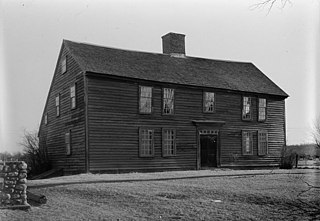
A saltbox house is a gable-roofed residential structure that is typically two stories in the front and one in the rear. It is a traditional New England style of home, originally timber framed, which takes its name from its resemblance to a wooden lidded box in which salt was once kept.
Connecticut's 3rd congressional district is a congressional district in the U.S. state of Connecticut. Located in the central part of the state, the district includes the city of New Haven and its surrounding suburbs.
The Stewart B. McKinney National Wildlife Refuge is a 950-acre (384.5 ha) National Wildlife Refuge in ten units across the U.S. state of Connecticut. Located in the Atlantic Flyway, the refuge spans 70 miles (110 km) of Connecticut coastline and provides important resting, feeding, and nesting habitat for many species of wading birds, shorebirds, songbirds and terns, including the endangered roseate tern. Adjacent waters serve as wintering habitat for brant, scoters, American black duck, and other waterfowl. Overall, the refuge encompasses over 900 acres (364.2 ha) of barrier beach, intertidal wetland and fragile island habitats.

Hilliard Mills is a historic mill site located at 642 Hilliard Street in Manchester, Connecticut, west of Adams Street. The property consists of six buildings comprising roughly 104,000 square feet of space, spread over five acres at the confluence of the Bigelow Brook and Hockanum River. Hilliard Mills is listed on the State of Connecticut Register of Historic Places.

The Quinnipiac Trail is a 24-mile (39 km) Blue-Blazed hiking trail in New Haven County, Connecticut. It is the product of the evolution and growth of the first 10.6-mile (17.1 km) trail designated in Connecticut's Blue-Blazed Hiking Trail system, with its light-blue rectangular vertical painted blazes.
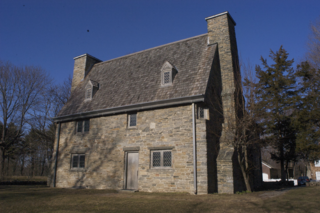
The Henry Whitfield House is a historic house located in Guilford, Connecticut, down the street from the town green. This house dates from 1639, having been built just before the town of Guilford was settled. It is the oldest house in Connecticut and the oldest stone house in New England. The house, with its massive stone walls, also served as a fort to protect the community. Henry Whitfield, for whom the house was built, was a Puritan minister who had come from England to flee religious persecution. The house was remodeled in 1868 and opened to the public in 1899 as the first museum of the State of Connecticut, the Henry Whitfield State Museum. The house was restored in 1902–04 and in the 1930s and was declared a National Historic Landmark in 1997. It was named a State Archeological Preserve in 2006.
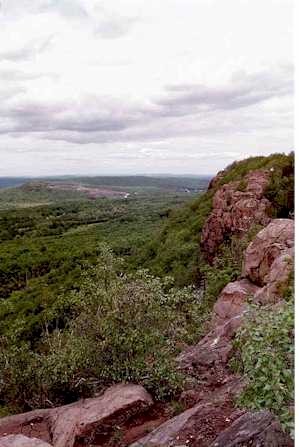
The Mattabesett Trail is a 62-mile (100 km) long, hook-shaped blue-blazed hiking trail in central Connecticut and a part of the New England National Scenic Trail. One half of the trail follows the high traprock ridges of the Metacomet Ridge, from Totoket Mountain in Guilford, Connecticut, to Lamentation Mountain in Meriden, Connecticut, from south to north. This ridge is known for its biodiversity, miles of scenic cliffs, and rugged hiking. The second half of the trail extends north from Guilford to Middletown, Connecticut, and ends at the Connecticut River. Here, the trail follows an upland of metamorphic rock with occasional views and dense forests.
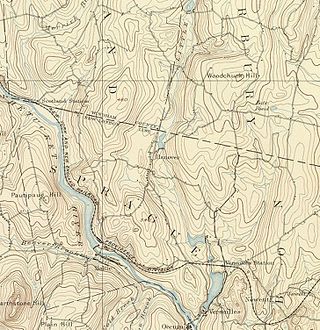
Hanover is a small community in Sprague inside New London County, Connecticut. In the 2010 US Census the population was 67, but in 2014 the estimated population was 59. The main road, Hanover Rd., leads south to Route 138 and north to Route 14 in Scotland, while Salt Rock Rd. leads to Route 97. The Little River runs through the eastern part of the area. Hanover Reservoir is the largest body of water in the area. In the center of the village, some notably old houses are located there. Some are on the National Register of Historic Places. The ZIP Code for Hanover is 06350.
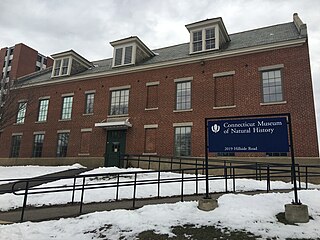
The Connecticut State Museum of Natural History was located in Storrs, Connecticut, as part of the University of Connecticut.

The Nipmuck Trail is a Blue-Blazed hiking trail "system" which meanders through 34.5 miles (55.5 km) of forests in northeast Connecticut. It is maintained by the Connecticut Forest and Park Association and is considered one of the Blue-Blazed hiking trails. There are two southern trail heads in the south of the town of Mansfield, Connecticut. The southwestern terminus is at a road shoulder parking place on Puddin Lane, and the southeastern terminus is a DEEP parking lot on North Windham Road at the southeast corner of Mansfield Hollow State Park. The northern terminus is at the north end of Breakneck Pond along the Massachusetts border in Nipmuck State Forest. Camping permits may be obtained for up to five separate locations for backpacking.

The First Church in Windsor, Connecticut is the oldest Congregational church in Connecticut. Its origin can be traced back to 1630, when 140 men and women sailed out of Plymouth, England on the Mary & John. This was the first of 17 ships in the so-called Winthrop Fleet, bound for the Massachusetts Bay Colony. When they heard from the Indians about the fertile land along the Connecticut River in what is now called the Connecticut River Valley, a small contingent of settlers travelled southwest and established the first settlement in Connecticut at Windsor in 1633. Word soon spread that Windsor was a good place in which to settle: in 1635, the congregation of the First Church departed from their homes in Dorchester, Massachusetts to relocate to Connecticut.

The Loomis Homestead in Windsor, Connecticut, is one of the oldest timber-frame houses in America. The oldest part of the house, an ell adjacent to the main house, is believed to have been built between 1640 and 1653 by Joseph Loomis who came to America from England in 1638. Later additions to the Loomis house were made around the turn of the eighteenth century. The preserved house is now adjacent to the well-known Loomis Chaffee School, which was founded by Loomis' descendants who donated the surrounding farm land of the original homestead for the grounds of the school.
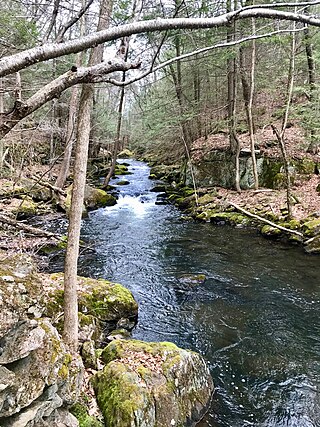
The 'Hancock Brook Trail' is a 2.8-mile (4.5 km) Blue-Blazed hiking trail Waterville Section of the City of Waterbury in New Haven County close to the borders of Thomaston and Plymouth, Litchfield County, Connecticut. It is contained overwhelmingly in a section of the Mattatuck State Forest bounded by Hancock Brook on the east, Thomaston Avenue on the west and Spruce Brook Road / Route 262 to the north.
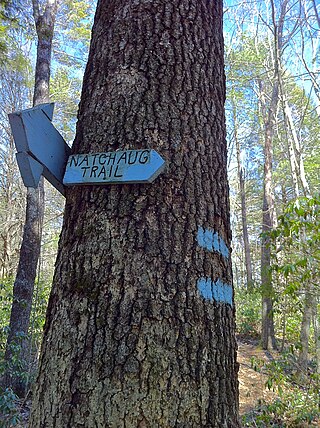
The Natchaug Trail is a Blue-Blazed hiking trail "system" which meanders through 19.5 miles (31.4 km) of forests in northeast Connecticut—primarily in Windham County. It is maintained by the Connecticut Forest and Park Association. Its southern trailhead begins in the James L. Goodwin State Forest in the towns of Chaplin, Connecticut and Hampton, Connecticut and the northern terminus is at its intersection with the Nipmuck Trail in Natchaug State Forest in Eastford, Connecticut.

The Menunkatuck Trail is an 11.0-mile (17.7 km) Blue-Blazed hiking trail in Guilford, Connecticut and, currently, is almost entirely on protected land owned by the Town of Guilford, the Guilford Conservation Land Trust, the Regional Water Authority (RWA) and on Cockaponset State Forest land.

The Chatfield Trail is a 4.6-mile Blue-Blazed hiking trail located within the town of Killingworth, Connecticut.

Comfort Starr was a 17th-century English physician who emigrated to the Thirteen Colonies. He was one of the five founders of Harvard College.




















